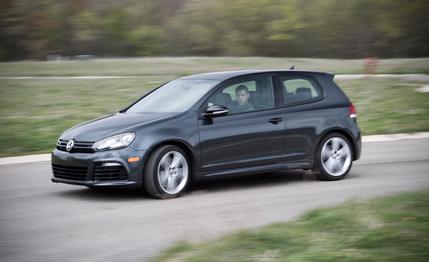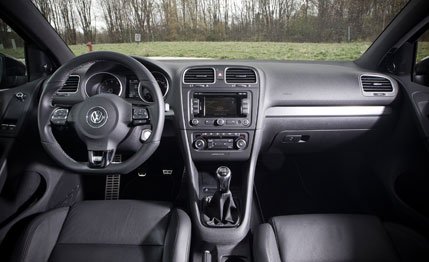
 Instrumented Test
Instrumented Test




Four years after the dual-clutch-automatic-only R32, Volkswagen returns to the white-hot-hatch arena with the Golf R. For this iteration, VW dropped the automatic in favor of a manual, and for the first time stateside, the meanest Golf comes as a five-door for a $600 premium over the three-door. As with the R32, the R is limited to 5000 units in the U.S.
VW also dumped the R32’s six-cylinder for a detuned version of the Audi TTS’s 2.0-liter turbo four making 256 horsepower and 243 pound-feet of torque. It trumps the R32’s output of 250 and 236, respectively.
The four-cylinder/manual combo shaved about 200 pounds from the R; curb weight is now 3354. That left us scratching our heads over the 5.9-second 0-to-60-mph time we measured, which is 0.5 second slower than the R32’s. Explanation: Manual shifting and our fanciest footwork can’t compete with the R32’s launch control. The R’s power-to-weight advantage shows up at the top end where it reaches 120 mph in 23.1 seconds, 1.0 second earlier than in the R32. Speed builds smoothly and stealthily here; the torquey engine feels like a miniature version of a big Bentley’s.


Comparing the R with the hard-edged Subaru Impreza WRX STI or even harder Mitsubishi Lancer Evo MR is inevitable and not to the VW’s advantage—it is slower, takes longer to stop, and corners more softly. All-season 18-inch rubber hampers the R. Compared with a GTI wearing all-seasons, the R’s 0.86-g skidpad score is less grippy by 0.02 g and its 186-foot 70-to-0 braking distance is 11 feet longer despite larger and vented rear discs. We’d bet that an R wearing summer tires would reestablish the hierarchy; too bad they’re not a factory option.


Without badges, distinguishing a $34,760 R from an equivalently equipped $30,765 GTI with the Autobahn package isn’t easy. Four grand may still seem like a lot for questionable performance gains. Our car came fitted with the model’s only option: a $1500 bundle including a sunroof, a navigation system, keyless entry, and an upgraded stereo.
The subtle styling doesn’t convey that the addition of the rear drive axle balances the weight a tad better and that this is the best Golf chassis to date. Turn-in is crisp, with understeer progressively building to the limit. Chucking the car into corners, a technique prevalent among drivers in this class, can induce both yaw and stability-control activity. (As with most other VWs, electronic safeguards are always engaged.)
Everyday livability is on par with that of a standard Golf, which is to say good; it’s luscious when compared with an Evo’s. It is this, the powertrain’s sublime sophistication, and its contemporaries’ lack of maturity that will move every last R. Its limited numbers should help, too.